One heckuva ride: Roller coaster continues in beef business in 2018
BEEF’s annual State of the Industry survey shows a drop in both short-term and long-term optimism.

One glance at BEEF’s Producer Optimism Index, derived from our annual State of the Industry survey, reveals a fundamental truth about being in the cattle business — it is often a roller coaster of an emotional ride, with ups and downs in the outlook as factors both internal and external change from year to year.
After rebounding last year, readers’ optimism seems to have turned south once again, as beef producers face a wide array of weather challenges, the prospect of more beef production and lower cattle prices in the next few years, and uncertainty over international trade. However, a closer look at BEEF’s Producer Optimism Index shows long-term optimism is still above the baseline 100 level, illustrating that even in the face of lots of challenges, beef producers know that while the ride may be bumpy, it’s a marathon and not a sprint when you’re in the beef business (Figure 1).
A look at the results
BEEF’s Producer Short-Term Optimism Index shows just how up and down emotions can run. Looking at the general trend from 2011, the high point in readers’ short-term optimism, through this year’s results, shows a general downward trend in short-term optimism by BEEF readers. Even years like 2014 and 2017 couldn’t match the level of optimism notched in 2011 (Figure 2).
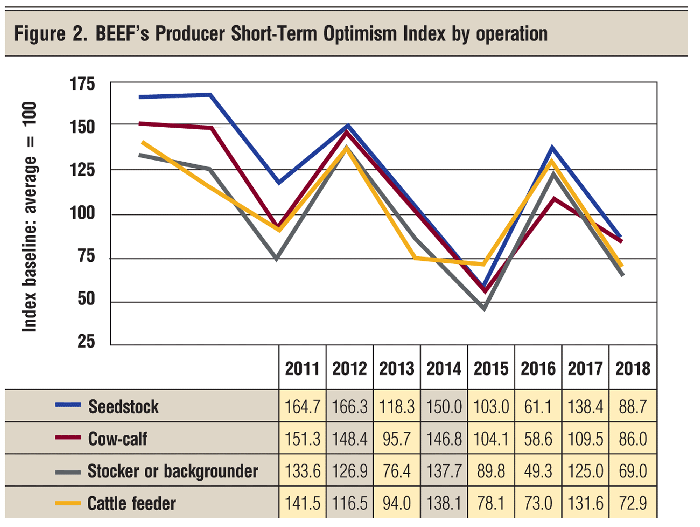
However, the majority of respondents are keeping the present challenges in perspective. When we asked readers about their short-term optimism, nearly 60% said it was about the same, while 12.2% said they are more optimistic and nearly 30% said they were less optimistic (Figure 3). The possibility of higher input costs was far and away the biggest reason from among the choices given when those who are less optimistic were asked why (Figure 4).
But underlying that is the uncertainty that many are feeling about the international trade situation, and the possibility of a trade war with China. Lump in the uncertainty over what cattle prices will do the rest of the year and beyond, and the potential for fake meat, and the pensiveness gets even higher. Just like markets, those who rely on them for their livelihood don’t deal with uncertainty very happily.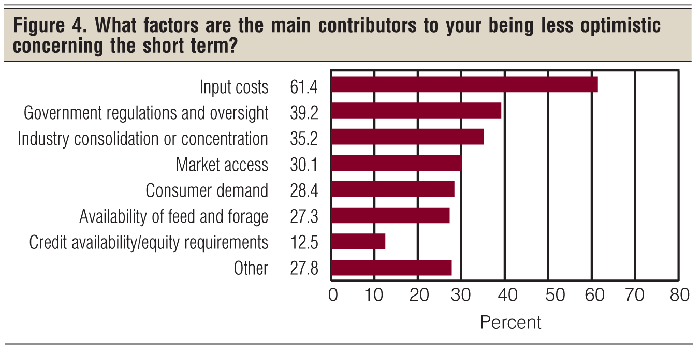
However, on the flip side of the international trade coin, those who are more optimistic about the short-term future of the beef business listed international demand as their top choice, followed closely by domestic demand, and supply and demand fundamentals (Figure 5).
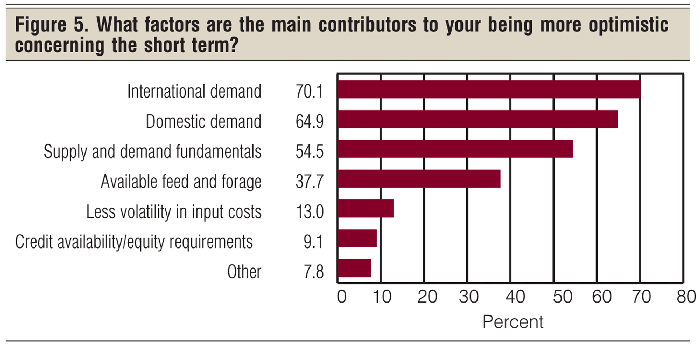
Like the short-term index, the long-term trend in producer optimism shows a similar path, at least until the last two years. The optimism shown last year has been tempered some in 2018, but not so much that it appears to have a dark cloud hovering over it — although in parts of cow country fighting a devastating drought, dark clouds may well shoot the optimism index higher (Figure 6).
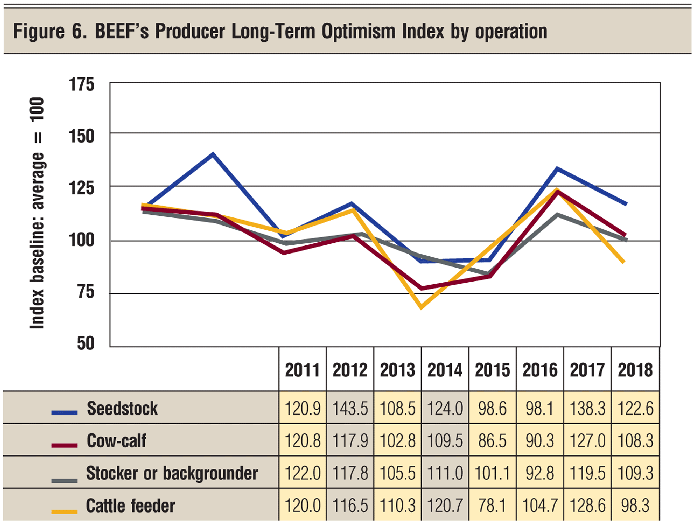
When asked about their level of long-term optimism, 56.5% said it’s about the same, while nearly 30% said they are more optimistic than last year and 17.6% indicated their optimism has slipped from a year ago (Figure 7).
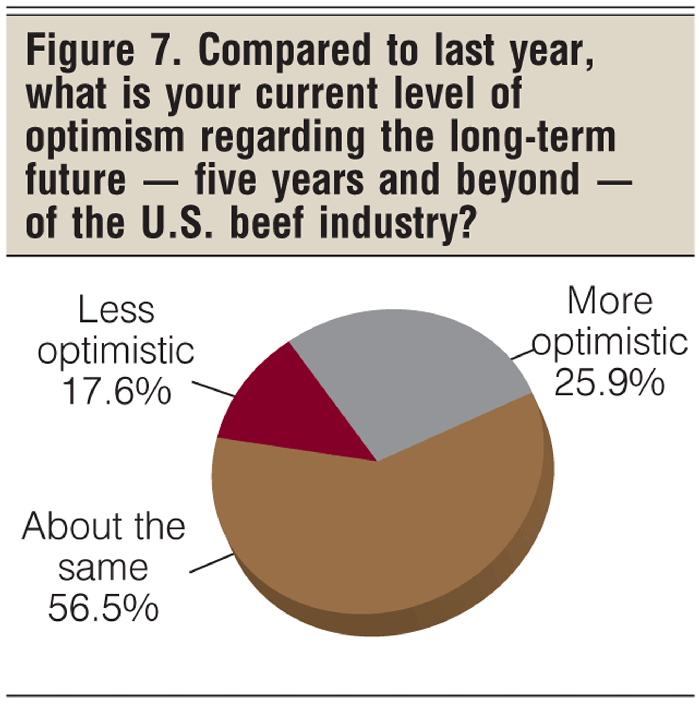
For those who are less optimistic about the long term, 62% said input costs were again the main concern, followed closely by government regulation and oversight of the beef business at 56.5% (Figure 8).
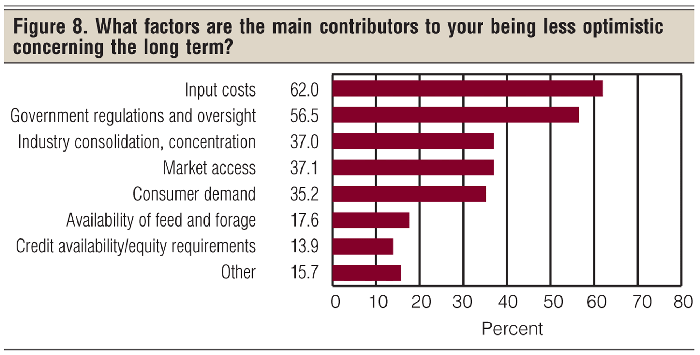
For those who are more optimistic about beef’s long-term future than they were last year, the outlook for international beef demand led the charge with international demand getting top ranking at just over 78%, followed by domestic demand at nearly 61% and supply and demand fundamentals at slightly more than 56% (Figure 9).
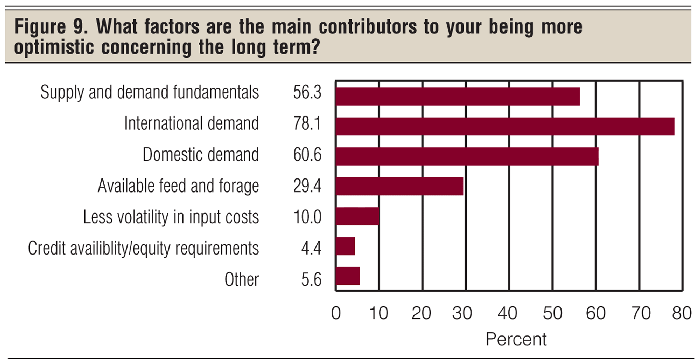
When analyzing the responses to the short-term and long-term questions, it becomes a glass-half-full outlook versus a glass-half-empty worldview. Indeed, how you perceive the challenges and opportunities around you colors your overall outlook on your business and life.
Let’s continue to follow the thread of international beef demand. When asked, “How important do you believe international beef trade is to U.S. cattle prices?” slightly more than 56% replied it’s essential; more than 37% said it’s important (Figure 10). Combine those two, and more than 93% of respondents think international trade is important to the future of the beef business.
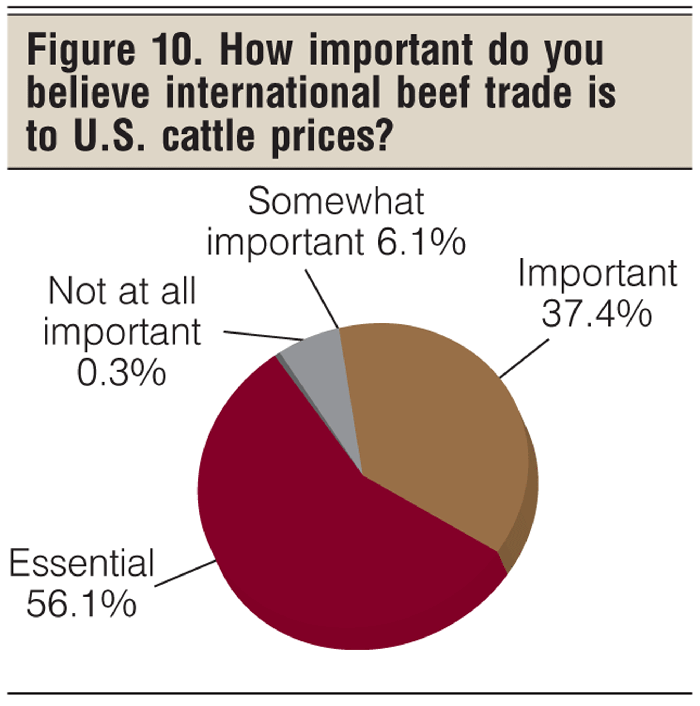
Has that opinion changed since last year? To an extent, yes. Almost 54% said their viewpoint on free trade is about the same as last year, while more than 37% are more in favor of trading with our overseas partners. Only 8.1% are less in favor of international trade (Figure 11).
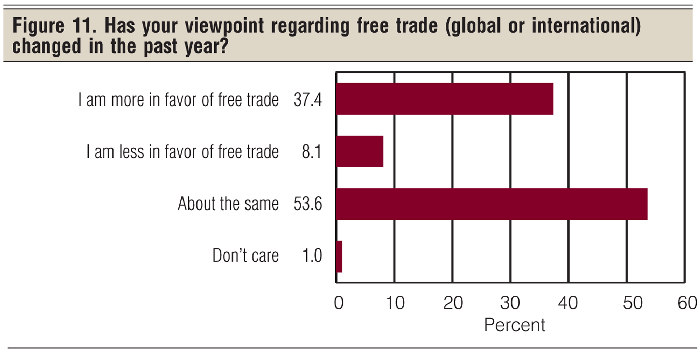
What about NAFTA? The North American Free Trade Agreement has been in the news a lot, given President Donald Trump’s sword-waving on the issue. And some groups within the cattle business are against the idea.
But it appears a majority of BEEF readers think it’s been good for their business. When asked, “Has NAFTA been positive for U.S. beef producers?” almost 67% replied yes while slightly more than 33% said no (Figure 12).

Other responses
Past market signals gave a green light to begin building cow numbers. Even in the face of the increased beef supply in 2018, brought on by more cows and heifers in the breeding herd, a fair number of readers who responded to the survey indicated they plan to keep their foot on the gas pedal. Slightly more than 22% of respondents said they plan to expand their herd size by 1% to 10%, and 8% of respondents plan to expand by more than 10%.
On the other hand, almost 13% plan to reduce their herd size 1% to 10%, and just above 9% will reduce numbers by more than 10%. Most, however, at more than 47%, plan to keep herd size stable (Figure 13).
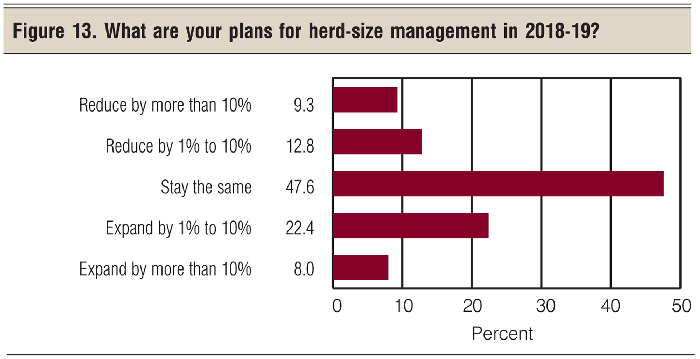
This year’s figures are off some from last year, at least for those who plan to expand. In the 2017 survey, 29% indicated plans to expand by 1% to 10%, while 10.5% of respondents said they planned to expand by more than 10%.
On the other hand, 10% planned to decrease their herd size by 1% to 10%, and nearly 8% said they planned to cut numbers by more than 10%. And just over 42% planned to keep numbers about the same.
Given the potential for lower cattle prices as beef supplies grow, managing input costs becomes even more important. When asked which strategies readers are using to decrease feed costs, nearly 51% are altering forage management, while just over 33% are putting more pounds on their cattle before selling, and a little more than 21% are reducing cattle numbers. Interestingly, however, more than 22% aren’t using those strategies (Figure 14).

Adjusting your marketing techniques to current market conditions is another way to get through the high cattle numbers and lower prices part of the cattle cycle. Respondents were evenly split when asked if they plan to retain ownership of their 2018 calves through the stocker phase, with almost 44% saying yes and nearly 45% saying no (Figure 15).
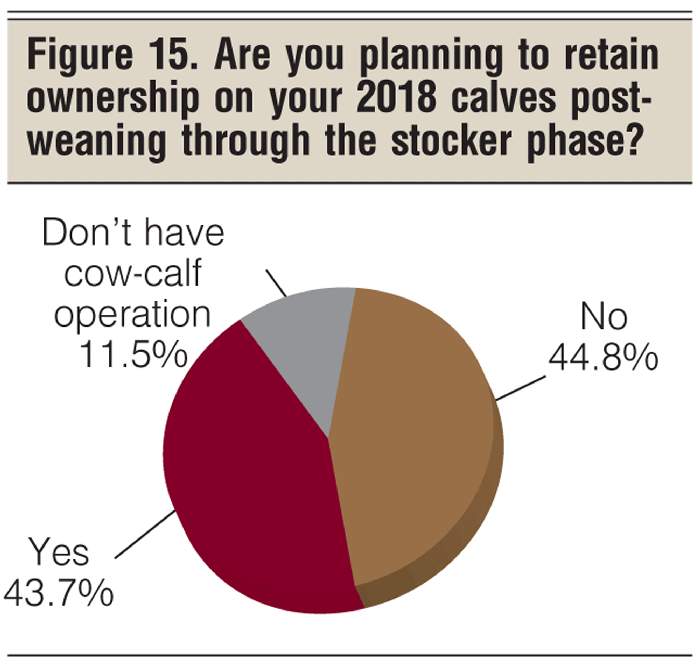
And a few will carry their calves all the way through the feedyard, with 24.5% notching the yes answer and 75.5% who said no (Figure 16).

This year’s figures are roughly the same as last year’s responses. Last year, 47% of respondents said they plan to retain ownership through the stocker phase, while 44% said no. And 26% planned to retain ownership through the feedyard, with 74% indicating they weren’t.
We’re halfway through 2018, and it’s shaping up to be a year of remarkable uncertainty. Will domestic and international beef demand be enough to keep the market from spiraling downward as we enter the last half of the year? Time will tell.
But as always, BEEF readers will adapt and adjust to whatever is thrown at them. After all, being in the beef business is a marathon, not a sprint.
About the Author(s)
You May Also Like



